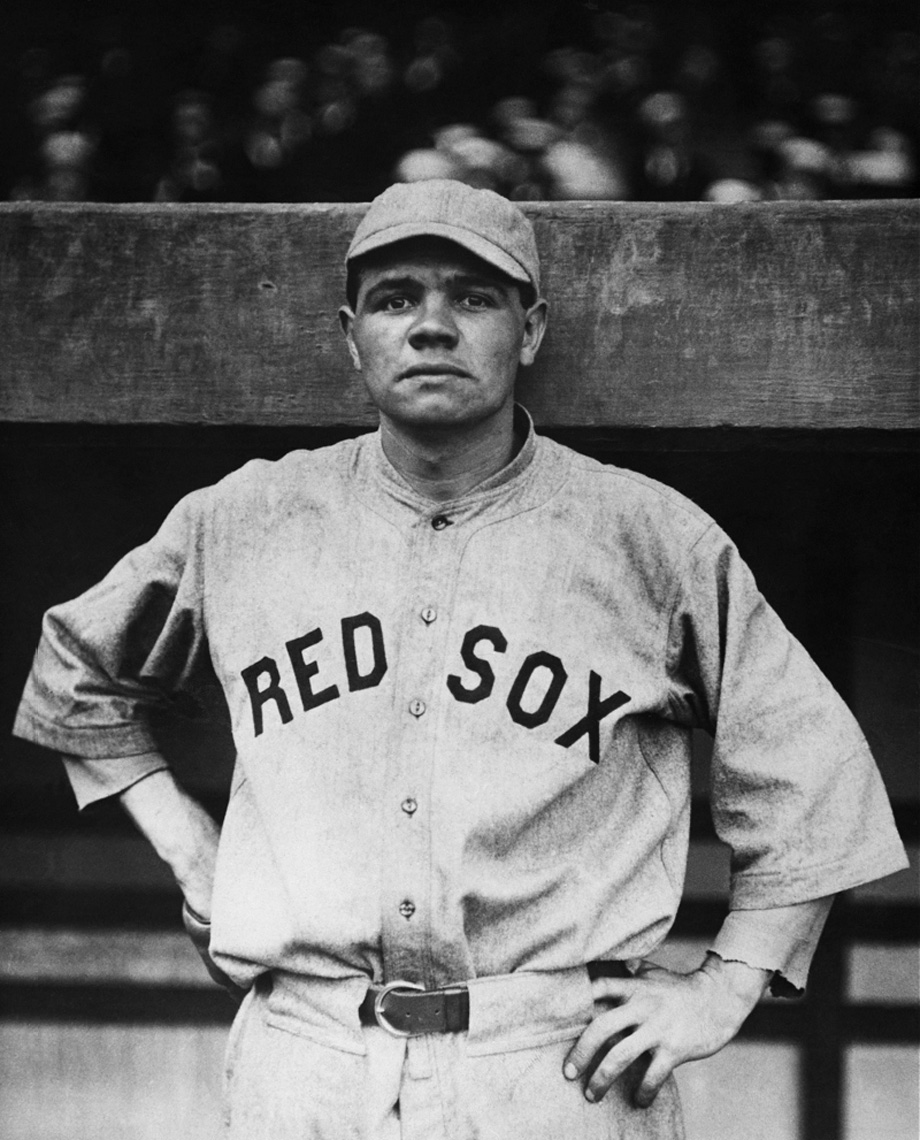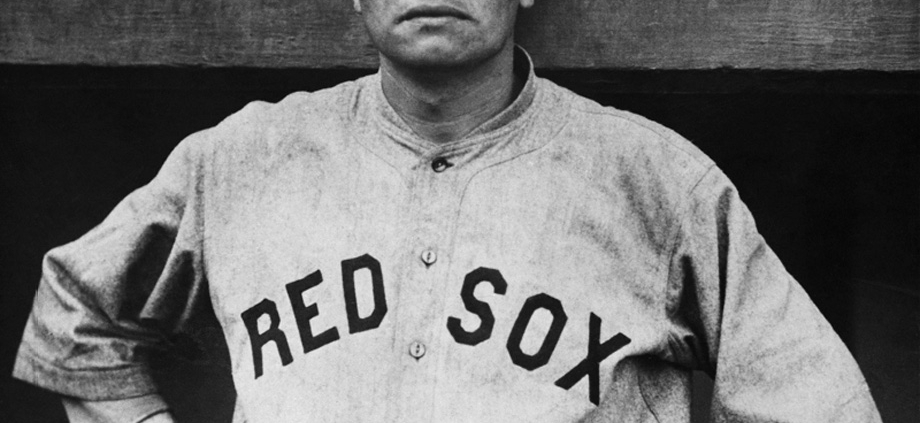July 29, 1919: Babe Ruth’s blast ties AL record as Boston goes down swinging
 There was no highly hyped home-run chase in 1919. That’s one of the many things Babe Ruth put on the baseball map.
There was no highly hyped home-run chase in 1919. That’s one of the many things Babe Ruth put on the baseball map.
First, he raised the home run to an art form and a focal point, after decades of 90-feet-at-a-time offense in the Deadball Era. Then, when Ruth slammed 60 home runs in 1927, every subsequent slugger would be measured against that mighty stick, with the press breathlessly comparing each challenger’s pace against the Babe day by day.
But in 1919, the home run was still more of an afterthought, and so was the American League record for home runs in a season. It was held by Ralph “Socks” Seybold, who clubbed 16 circuits for the Philadelphia Athletics in 1902. So as Babe Ruth took the field at Fenway Park for a series-opening game with the Detroit Tigers, sitting on 15 home runs, his chances of matching Seybold came with little fanfare and little suspense. After all, it was only July.
In fact, Babe’s subsequent feat did not appear in the headline of the game report in the Detroit Free Press, and did not warrant mention until the seventh paragraph.1
Instead, the focus going into the game, which matched Hughie Jennings’ third-place Tigers (48-37) against Ed Barrow’s sixth-place Red Sox (37-46), was on the pitchers, who were not expected to allow the shootout that was about to unfold. After all, Dutch Leonard and Paul Musser had matched up exactly one week before at Navin Field in Detroit, with the Tigers pulling out a narrow 2-1 win. Musser, whom the Boston Globe called the “strike-out king of the Western League,”2 had just been called up and was solid in his Red Sox debut, striking out seven but getting stuck with the loss.
Early on in the rematch, it looked as if another pitchers’ duel might be in store.
“Musser started like a thoroughbred from a barrier, striking out his first two batters,” the Free Press reported.3 Ty Cobb flared a single into center field, but cut the inning short when he “strayed too far off the bag and was run down.”4
Boston took the lead in the bottom of the inning on a base hit by Braggo Roth that scored Harry Hooper, and Musser preserved it in the second. A walk to Harry Heilmann was his only mistake, and that was erased when, as the Free Press said, “Harry died stealing.”5
But the Tigers pounced on Musser in the third inning, overcoming his oral output of “saliva that he decorated the pill with,” according to the Free Press, and giving Musser “a beating that he isn’t apt to cherish.”6
Third baseman Bob Jones led off with a walk and moved to second on a sacrifice by catcher Eddie Ainsmith. After Leonard was retired, Donie Bush and Ralph Young banged back-to-back singles, pushing across Jones and then Bush. The Tigers took the lead, 2-1.
Detroit poured on the pressure in the fourth. Bobby Veach singled to center and then made it to second on a steal attempt that would have fallen short before second sacker Red Shannon dropped what the Globe called “Schang’s perfect throw.”7 Chick Shorten reached on an error by former Tiger Ossie Vitt at third, and Shorten and Veach marched home when Ainsmith, “catching one of Musser’s heaves where he wanted it, clubbed over Roth’s head for three bases,” the Free Press said.8 Then Leonard joined the attack with a single to score Ainsmith before the Tigers were finally silenced, having claimed a 5-1 lead.
In the bottom of the inning, Boston turned to Babe Ruth. The left fielder came up with one out and bashed a double, then advanced to third on a wild pitch to catcher Wally Schang, who drew a walk. Del Gainer knocked a grounder to third, where Jones “made a great stop on Gainer’s drive, but threw wild to second,” sending Schang to third and Gainer to second while Ruth made it home.9 Schang scored on Shannon’s groundout, and then, with two outs, Everett Scott bunted and made it to first to get Gainer home. After an eventful fourth inning, it was a competitive game again, with the Red Sox trailing only 5-4.
But not for long. Young walked and would have scored on a deep drive by Cobb, only to have Hooper make the defensive play of the game, a running catch followed by a crash into the wall. “With momentum enough to have carried it three feet further the ball would have landed in the bleachers for a home run,” the Globe said, but Cobb couldn’t even settle for an extra-base hit after Hooper’s heroics.10 Then Veach doubled home Young, Heilmann singled to shift Veach to third, Shorten hit a sacrifice fly to complete Veach’s trip, and Jones pelted a base hit to score Heilmann and open up an 8-4 Tigers lead.
Ruth would mount an answer once more. With two out and one on, he belted a double to move Hooper to third, and both men reached where they started on a base hit by Schang. The Red Sox were back within striking distance, trailing 8-6 after seven innings.
Ray Caldwell began his third inning of work in the top of the ninth inning. He had taken over for Musser, who was lifted for a pinch-hitter in the sixth inning. Caldwell had known Fenway Park from the very beginning; he was the first opposing pitcher in the park’s opener in 1912, with the Highlanders.11
Now, after two scoreless frames, Caldwell gave the Tigers the breathing room they would end up needing. He walked Young, who was forced out on a fielder’s choice by Cobb, then surrendered three straight singles to score two runs and let Detroit reach double digits. The Red Sox moved to the bottom of the ninth trailing 10-6.
Leonard retired Hooper and Vitt on fly balls, bringing up Roth with Ruth on deck. For some reason, Leonard elected to walk Roth and face the Babe.
“It would be interesting to know just what Leonard had in mind by deliberately passing Roth and bringing Ruth to bat in the ninth,” the Globe puzzled.12
It was a big mistake. “The first ball he sent up was a high, fast one, which Ruth met fair, and sent into the centre field bleachers.”13
“Ball and bat met, and the apple sailed among the fans,” the Free Press ruefully reported.14
It was home-run number 16 for Ruth, tying Seybold. Once again, Ruth had single-handedly made the game close. But his blast was Boston’s last gasp, and the Red Sox lost 10-8.
With the win the Tigers moved into second place, taking advantage of losses by Chicago and Cleveland, which split a doubleheader.
Every Tiger tallied at least one hit. Veach, whom the Free Press identified as “the left gardener in the Jungle clan,” finished with “a regular field day” of three hits.15
“The Bengals grouped 12 robust wallops for 10 honest trips around the route of bases,” the Free Press crowed. “The contest was typical of the Tigers when they measure a victim for the morgue, and attend the obsequies.”16
Fittingly, despite all the offense, it was characteristic of the pre-1920 variety, with Ruth’s final shot being the only ball to clear the fence.
But Babe was on the brink of changing the game of baseball. The imminence of a new record was clear, as Ruth still had two months left in the season to beat Seybold and make a run at Ed Williamson’s major-league record of 27 round trippers for the Chicago White Stockings in 1884.17
“Nothing but a world’s record for home runs by Ruth will now satisfy the Boston fans,” the Globe said, “and his chances of setting one are pretty good.”
But the Globe figured that history had already been made. After all, it pointed out, Williamson’s mark was “made in small parks which cannot be compared with those of the present day, and which makes Ruth’s performances all the more remarkable.”
Notes
1 Harry Bullion, “Paul Musser Finds Tigers Bad Seconds,” Detroit Free Press, July 30, 1919: 12.
2 James O’Leary, “Ruth Gets His 16th Home Run of Season,” Boston Globe, July 30, 1919: 6.
3 Bullion, “Paul Musser Finds Tigers Bad Seconds.”
4 Ibid.
5 Ibid.
6 Ibid.
7 O’Leary, “Ruth Gets His 16th Home Run.”
8 Bullion, “Paul Musser Finds Tigers Bad Seconds.”
9 O’Leary, “Ruth Gets His 16th Home Run.”
10 Ibid.
11 He would soon make more history: The Red Sox would release him before he made another appearance with them. In his first game with Cleveland, he would get struck by lightning on the mound, only to rise and finish a complete game. Then, his 1919 campaign having lacked sufficient excitement, he would throw a no-hitter in September.
12 O’Leary, “Ruth Gets His 16th Home Run.”
13 Ibid.
14 Bullion, “Paul Musser Finds Tigers Bad Seconds.”
15 Ibid.
16 Ibid.
17 He would finish with 29, then bash 54 in his first year with the Yankees in 1920.
Additional Stats
Detroit Tigers 10
Boston Red Sox 8
Fenway Park
Boston, MA
Box Score + PBP:
Corrections? Additions?
If you can help us improve this game story, contact us.


